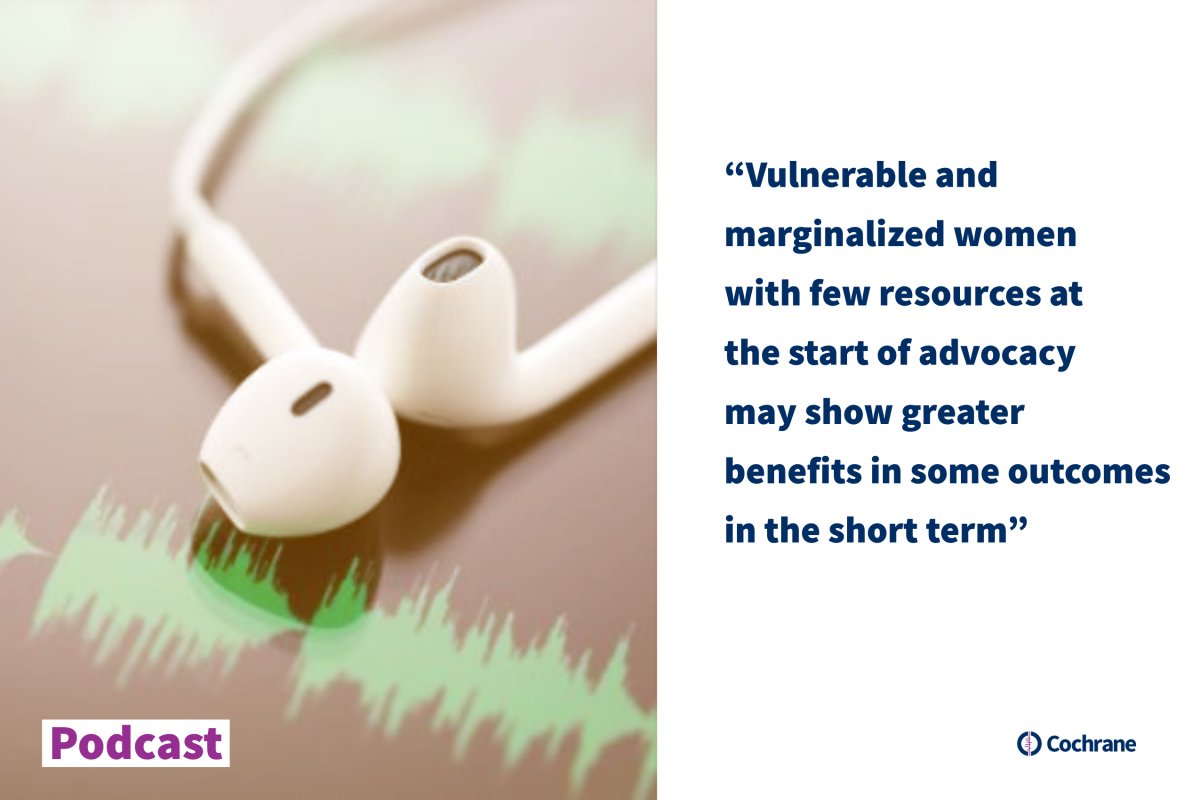
Almost all Cochrane Reviews use a systematic methodology in which the rules for including a study are clearly defined in advance, the researchers try to find and include all such studies and seek an estimate of the size of the effect of an intervention or the accuracy of a diagnostic test. However, some researchers wish to look more at why and how interventions or actions work, and a realist approach might be more appropriate for their review. One of the first such Cochrane reviews was published in June 2019, assessing advocacy interventions for abused women, and we asked lead author, Carol Rivas from University College London in the UK, to tell us more.
Domestic violence between intimate partners is very common, and advocacy is a formal support service that might help the person being abused. Our review looks at its use for abused women, as interventions for abused men require different considerations.
Advocacy may be stand‐alone or part of other services such as healthcare, the criminal justice system or social, government or specialist domestic violence services. It primarily involves educating an abused woman about domestic violence and supporting her to be safe. It also involves helping her to access other services, such as housing. Advocates may be trained women who have been abused in the past, staff or trainees from the various settings, or domestic violence experts.
The variability between advocacy services makes it difficult to understand what works for whom and when and where, and we wanted to investigate all these factors. Doing a realist review allowed us to delve more deeply into these issues about how an intervention works and what it might lead to in routine practice rather than a pure research setting. We considered any type of study as long as it had information on at least two from context, outcomes and mechanisms. Mechanisms are those things that lead to a particular response and one example is educational content which helps each abused woman to make sense of her own unique experiences.
We found research from 15 countries and 88 of the 98 included studies were core to answering our questions. Of these, 37 asked advocates about their views and experiences, while only seven asked abused women, two of which also asked staff. The other 44 core studies helped us understand the way advocacy works and how effective it is.
In summary, we found that advocacy can help abused women, if undertaken for long enough and if its goals are matched to each woman's needs. But it’s also clear that a woman may experience both benefits and less desirable trade-offs.

At the individual level, we identified that advocacy work should consider women’s existing access to and control over financial, legal, social, emotional and knowledge resources; and it is insufficient to simply provide them with access to these resources. They also need help to develop the capabilities to use them.
Sometimes, there is a positive chain of effect from advocacy. But in the short term it might lead to negative changes, such as depression as a woman gets more insight into her situation or leaves the abuser and has to move to a different area. Abused women receiving advocacy need to understand there are always trade‐offs with any decision they make; and some women may tolerate the abuse if they consider the trade‐offs of not doing so to be worse. Advocates need to accept this, which they find hard to do.
At the local level, we found communities may support or constrain abused women’s use of advocacy and advocates. We also found that advocates are affected by whether they have local and national economic resources, ongoing training or guidance, and links to support from their colleagues or other organizations. They were often worried about crossing from a professional to a personal role in ways that might be harmful to themselves or to the women. They could experience burnout, especially if they were survivors of abuse, though being a survivor or of the same ethnicity as the abused woman was considered helpful. This makes it important to provide support for advocates.
In conclusion, our review helps explain why studies often don’t show strong benefits from advocacy or have mixed results. For example, it’s unlikely that one or two contacts with a woman will be sufficient to empower her, though they may change her safety behaviours. Vulnerable and marginalized women with few resources at the start of advocacy may show greater benefits in some outcomes in the short term. This includes women from minority groups or rural areas, those experiencing severe prolonged abuse and possibly pregnant women or those with children. These benefits indicate a low starting point rather than a ‘good outcome' and the women are likely to need a longer time within advocacy, as small steps may be more appropriate for them. Finally, advocacy work must take into account not only the abuser’s influence on the woman, but also that of her community and social networks.
